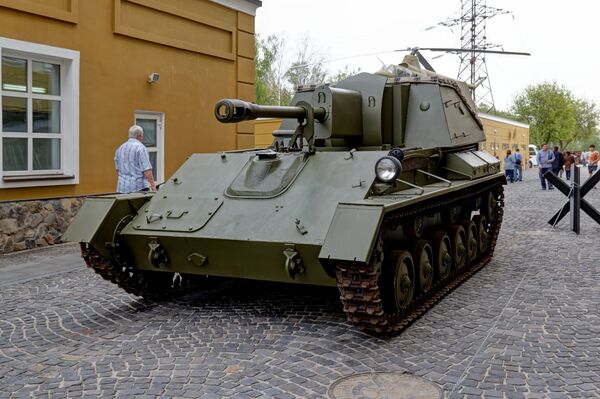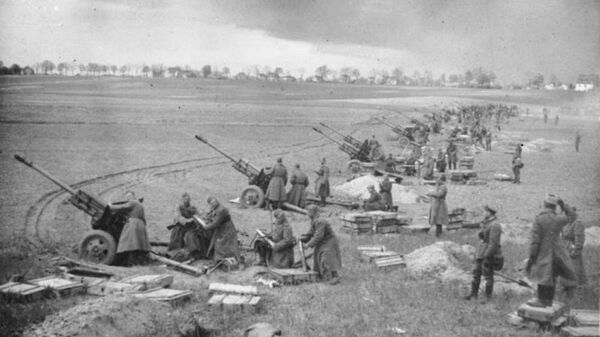As military observer Sergei Varshavchik explained in a recent piece for RIA Novosti, the ZiS-3 quickly became the dread of enemy armored vehicles and infantry alike.
After the Nazi invasion of the Soviet Union in June of 1941, the task of stopping the main striking power of the Wehrmacht, the Panzerwaffe, fell on the shoulders of artillery units. In 1941, the most widely-deployed anti-tank gun in the Soviet arsenal was the M1937, a 45-mm semi-automatic gun. That gun could easily take out 50-mm armor at a range of 500 meters, and its light weight and small profile made it both maneuverable and difficult to target for enemy tanks.
Unfortunately, early battles showed that the M1937's design made its crew very vulnerable to enemy mortar and artillery fire.
Early in the war, the Red Army had another anti-tank gun at its disposal, the 57-mm ZiS-2. This gun had problems of its own, with designers quickly realizing that it was too powerful for the tasks at hand, and too expensive to manufacture in large numbers. The ZiS-2 was temporarily removed from production in late 1941. However, the introduction of heavy tanks and self-propelled artillery by the Germans saw production of the ZiS-2 resume in 1943, with the gun placed on tanks or self-propelled artillery platforms.

In the meantime, divisional and anti-tank artillery units needed something less expensive but with similar characteristics. Furthermore, over 36,000 guns had been lost in the first year of the war, and replacements were needed, fast.
Structurally, Varshavchik noted, the ZiS-3 was similar to the ZiS-2. Military engineer Vasily Grabin had started work on the weapon before the war began. By that time, the 42-year-old designer had completed the artillery faculty at the Dzerzhinsky Military-Technical Academy, and spent many years at work at artillery factories, where he was tasked with creating new artillery designs.
In the 1930s, Grabin developed an ergonomic method for shortening the design planning phase for the creation of heavy guns. Grabin's method allowed for the development of new systems in months, and sometimes even weeks. His techniques allowed designers and engineers to save significantly on labor, energy, and metal required, all without compromising on quality.

During the design stage for the ZiS-3, Grabin immediately set his sights on its potential for mass production. This required reducing the number of steps necessary to build the gun; high quality casting of large components, mass production and component standardization allowed for the number of components to be reduced from 2,080 to just 1,306, which allowed the guns to be produced faster and more cheaply, without a loss in quality.
The gun's recoil was offset by a full 30% by a muzzle break device. Compared to its predecessor, the ZiS-3 was a full 420 kg lighter, had better clearance, and was designed to allow the 7 person crew to focus on their individual tasks, shortening firing time.
Trial by Fire, Literally
A pilot batch of ZiS-3s was sent to two artillery battalions at the front in December 1941, where the new artillery piece demonstrated its impressive capabilities. This literal 'trial by fire' allowed Grabin to personally present his new weapon system to People's Commissar of Defense Joseph Stalin in January 1942; Stalin officially signed off on the mass production of the gun shortly after.
The ZiS-3 would become one of the Eastern Front's most versatile weapons. The gun was designed to eliminate enemy infantry, machineguns, artillery, enemy tanks, armored vehicles, and to destroy enemy emplacements. Given its diverse set of targets, the gun was designed to fire an equally diverse range of shells, from high explosive grenades capable of destroying 75-cm thick brick walls, to shape-charge projectiles which would burn through enemy tank armor up to 90 mm thick.
Comparing the ZiS-3 to their own 75-mm gun, German artillery designers concluded that the Soviet weapon was superior on several parameters. For instance, the ZiS-3's design allowed it to fire shells that were 13% heavier than their German counterparts, and the weapon's enhanced range allowed it to fire from further away.
Also significant, Varshavchik noted, was the fact that the ZiS-3 did not have a tendency to burrow into the ground while firing, as many of its German counterparts did. This allowed its crew to take better account of threats coming from different directions, and to redeploy the gun quickly as necessary behind advancing infantry.
From 1942-1943, at distances between 700-900 meters, the ZiS-3 could easily disable almost every armored vehicle at the Wehrmacht's disposal.
However, beginning in 1943, with the appearance of the Tigers, Panthers, and heavy self-propelled guns, ZiS-3 crews found it next to impossible to penetrate these new systems' frontal armor.
In 1943, the ZiS-3's gun was attached to the T-70 light tank chassis, creating the Su-76 self-propelled gun. The Su-76's debut occurred at the Battle of Kursk, Nazi Germany's last attempt to carry out an offensive on Soviet territory.

From 1943-1945, over 14,000 Su-76 and Su-76M self-propelled guns were produced, making them the most heavily produced Soviet self-propelled guns of the Second World War. As for the ZiS-3, over 48,000 guns were built from 1942-1945, making it the most heavily produced artillery piece in history.
Ultimately, Varshavchik suggested that together with the T-34 tank and the Il-2 ground-attack fighter, the ZiS-3 is "one of the brightest symbols of the Red Army's victory in the Great Patriotic War."



